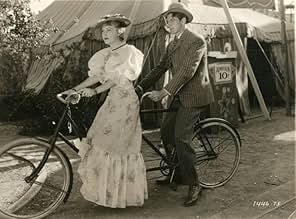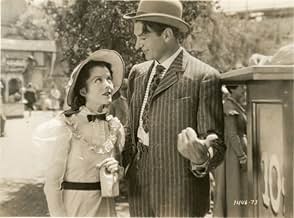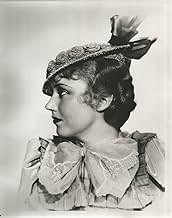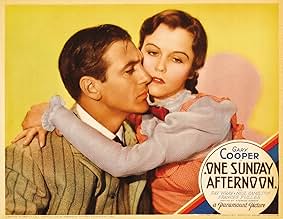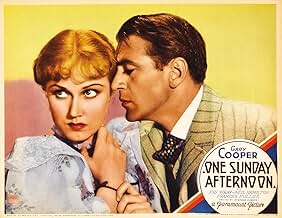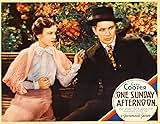Ajouter une intrigue dans votre langueMiddle-aged dentist Biff Grimes reminisces about his unrequited love for beautiful Virginia Brush and her husband Hugo, his ex-friend, who betrayed him.Middle-aged dentist Biff Grimes reminisces about his unrequited love for beautiful Virginia Brush and her husband Hugo, his ex-friend, who betrayed him.Middle-aged dentist Biff Grimes reminisces about his unrequited love for beautiful Virginia Brush and her husband Hugo, his ex-friend, who betrayed him.
- Réalisation
- Scénario
- Casting principal
Clara Blandick
- Mrs. Brush
- (scènes coupées)
Bobby Barber
- Man in Greased Pig Contest
- (non crédité)
James Bradbury Jr.
- Dink's Chum
- (non crédité)
Ed Brady
- Pig Contest Emcee
- (non crédité)
James P. Burtis
- Dink Hoops
- (non crédité)
A.S. 'Pop' Byron
- O'Reilly - Phoenix Foreman
- (non crédité)
Jack Rube Clifford
- Mr. Johnson - Watchman
- (non crédité)
Robert Homans
- Officer Charlie Brown
- (non crédité)
Carmencita Johnson
- Priscilla
- (non crédité)
Gus Leonard
- Musician
- (non crédité)
Jim Mason
- Dink's Chum
- (non crédité)
Russ Powell
- Tuba Player
- (non crédité)
Avis à la une
Gary Cooper plays a dentist named Biff whose former friend Hugo (Neil Hamilton) stabbed him in the back many times when they were younger and even wound up with the woman Biff loved, played by Fay Wray. Now Hugo has come to Biff to have a tooth pulled. While Hugo is sedated, Biff flashes back to how things went down between the two men. Good movie but later remake called The Strawberry Blonde is better. That one stars James Cagney, Olivia de Havilland, and Rita Hayworth. It's lighter and funnier than this one, which is dark in parts. Cooper's great here and his support is fine but I'm not sure Fay Wray was quite right for her part. This is yet another movie from the early '30s where Neil Hamilton played a man that women go crazy over. Something must have been in the water back then because I just don't see any woman preferring him to Gary Cooper. I remember another movie where he was picked over Clark Gable. Insane!
The film begins in a dental office, as the dentist, Biff (Gary Cooper), talks to a friend (Roscoe Karns) about this relationship with Hugo (Neil Hamilton) back in the Gay 90s when they had been friends. This is instigated when Hugo comes to the office and sees Biff for the first time in decades. Hugo needs a tooth pulled and while he is sedated with gas, Biff recalls their past when they were both ardently pursuing a pretty young lady (Fay Wray)--while pretty much ignoring her more plain but much sweeter friend (Frances Fuller). Through the course of the film, Hugo stabs his supposed friend in the back again and again.
This movie is the original--with remakes in 1941 (THE STRAWBERRY BLONDE) and 1948 (ONE Sunday AFTERNOON). While I rarely prefer remakes, I must say that the 1941 version is much more watchable and fun. Part of this is because the 1933 version is so very, very quiet--with very little music to help set the mood. Also, the whole mood of the 1933 film is more somber and the story a bit more direct and "bare bones" in style. Also, while I like Gary Cooper films, for a comedy like this one, Cagney was better and the supporting actors he had were also superior and gave THE STRAWBERRY BLONDE so much more energy. This film is still well worth seeing, but the 1941 film has a more polished plot, better characters and the full Warner Brothers package (wonderful and first-rate production values) that this Paramount film lacks.
This movie is the original--with remakes in 1941 (THE STRAWBERRY BLONDE) and 1948 (ONE Sunday AFTERNOON). While I rarely prefer remakes, I must say that the 1941 version is much more watchable and fun. Part of this is because the 1933 version is so very, very quiet--with very little music to help set the mood. Also, the whole mood of the 1933 film is more somber and the story a bit more direct and "bare bones" in style. Also, while I like Gary Cooper films, for a comedy like this one, Cagney was better and the supporting actors he had were also superior and gave THE STRAWBERRY BLONDE so much more energy. This film is still well worth seeing, but the 1941 film has a more polished plot, better characters and the full Warner Brothers package (wonderful and first-rate production values) that this Paramount film lacks.
"One Sunday Afternoon" is a charming and little-known piece of Americana, the first filmization of James Hagan's play about a dentist named Biff Grimes (Gary Cooper) who has long tried to revenge on his old friend Hugo Barnstead (Neil Hamilton) for marrying Grimes' girl Virginia (Fay Wray) and leaving him with the charming and devoted Amy (Frances Fuller). The film opens with Grimes and his pal Snappy Downer (Rascoe Karns) singing and drinking. Barnstead shows up Grimes' home to get this tooth pulled. Grimes puts him on nitrous oxide gas, and then the film dissolves into a flashback as Grimes remembers their past, providing him with a motive for revenge.
"One Sunday Afternoon" was remade in 1941 by Warner Bros. and Raoul Walsh into a timeless and unforgettable classic, "The Strawberry Blonde", starring James Cagney, Olivia de Havilland, and Rita Hayworth. Walsh's version is infinitely superior, but "One Sunday Afternoon" is worthwhile for Gary Cooper's superb performance.
"One Sunday Afternoon" was remade in 1941 by Warner Bros. and Raoul Walsh into a timeless and unforgettable classic, "The Strawberry Blonde", starring James Cagney, Olivia de Havilland, and Rita Hayworth. Walsh's version is infinitely superior, but "One Sunday Afternoon" is worthwhile for Gary Cooper's superb performance.
The exposition that takes place in a dentist's office, before the flashback that constitutes the major part of this film, seemed rather long to me. And the main character, Biff Grimes (Gary Cooper), seemed to be the least likable. So, I thought this film was going to be a drag.
But as the story develops, one learns that Biff, though a dense, insensitive lout, has an interesting story to tell. And the first part of the film is necessary to fully appreciate what follows.
I have always felt that Gary Cooper is best suited for characters that are socially awkward. Biff is just such a role. Cooper is surrounded by actors who outshine him at times. But they form a solid ensemble for this adapted play (that would be remade two more times in the forties). Fay Wray, in particular, amazes with her transformations throughout the film.
This plot is a simple story about revenge that no doubt pleased audiences of the depression era who looked to champion the common man.
But as the story develops, one learns that Biff, though a dense, insensitive lout, has an interesting story to tell. And the first part of the film is necessary to fully appreciate what follows.
I have always felt that Gary Cooper is best suited for characters that are socially awkward. Biff is just such a role. Cooper is surrounded by actors who outshine him at times. But they form a solid ensemble for this adapted play (that would be remade two more times in the forties). Fay Wray, in particular, amazes with her transformations throughout the film.
This plot is a simple story about revenge that no doubt pleased audiences of the depression era who looked to champion the common man.
One Sunday Afternoon is an example of what movie studios used to do with total professionalism - in the space of a few months, use a Broadway play as the template to make a movie. One Sunday Afternoon opened on Broadway on February 15, 1933; the movie went into production at Paramount in May 1933 and was released on September 1, 1933, while the original play was still at the Little Theater. Grand Hotel is another example of a Broadway play becoming a movie in a relatively short time.
Warner Bros. turned the play Arsenic and Old Lace into a movie after the play was a hit on Broadway, but by then, the play's producer knew the score. One Sunday Afternoon closed on Broadway in November 1933, a closure that probably was sped up by competition from the movie. As a condition of the sale of movie rights, the movie Arsenic and Old Lace, made in 1941, could not be released until the play it was based on closed on Broadway. That was in 1944.
Back to One Sunday Afternoon, the movie. As with many movies made during the Depression, this movie has a grim edge to it. Although things work out, all the leads have rough times of it. Fay Wray is cast against her usual role, playing a mean person. Gary Cooper is no hero, just a guy who gets jammed by people he trusted. Frances Fuller (Amy Lind) does not change much during the movie, she always believes in Biff Grimes (Cooper). She made one more movie in Hollywood as a lead character before vanishing until some television roles over 15 years later, so she did not have a chance to be typecast.
The end result of Paramount's production is a movie that shows what a struggle life is, and how people can change along the way. Instead of cheerful memories of a time gone by, which the title implies, you have scenes such as Gary Cooper returning from prison to meet Amy in Avery's Park, an amusement park that closed and fell into disrepair while Cooper was in prison.
One Sunday Afternoon is a slice of real life, a movie that deals with hard times for some ordinary (but very good looking) people.
Warner Bros. turned the play Arsenic and Old Lace into a movie after the play was a hit on Broadway, but by then, the play's producer knew the score. One Sunday Afternoon closed on Broadway in November 1933, a closure that probably was sped up by competition from the movie. As a condition of the sale of movie rights, the movie Arsenic and Old Lace, made in 1941, could not be released until the play it was based on closed on Broadway. That was in 1944.
Back to One Sunday Afternoon, the movie. As with many movies made during the Depression, this movie has a grim edge to it. Although things work out, all the leads have rough times of it. Fay Wray is cast against her usual role, playing a mean person. Gary Cooper is no hero, just a guy who gets jammed by people he trusted. Frances Fuller (Amy Lind) does not change much during the movie, she always believes in Biff Grimes (Cooper). She made one more movie in Hollywood as a lead character before vanishing until some television roles over 15 years later, so she did not have a chance to be typecast.
The end result of Paramount's production is a movie that shows what a struggle life is, and how people can change along the way. Instead of cheerful memories of a time gone by, which the title implies, you have scenes such as Gary Cooper returning from prison to meet Amy in Avery's Park, an amusement park that closed and fell into disrepair while Cooper was in prison.
One Sunday Afternoon is a slice of real life, a movie that deals with hard times for some ordinary (but very good looking) people.
Le saviez-vous
- AnecdotesWhen Biff asks for a package of Sen-Sen at the pool hall, audiences at the time would have known he was buying a popular brand of breath freshener. It was produced from the late 1800s until 2013.
- GaffesToutes les informations contiennent des spoilers
- Citations
Virginia 'Virgie' Brush Barnstead: How'd you know my name's Virginia?
Dr. Lucius Griffith 'Biff' Grimes: That's for me to know and you to find out.
- ConnexionsVersion of La blonde framboise (1941)
- Bandes originalesOn a Sunday Afternoon
(1902) (uncredited)
Music by Harry von Tilzer
Lyrics by Andrew B. Sterling
Played during the opening credits and at the end
Meilleurs choix
Connectez-vous pour évaluer et suivre la liste de favoris afin de recevoir des recommandations personnalisées
Détails
- Date de sortie
- Pays d’origine
- Langue
- Aussi connu sous le nom de
- Dr. Grimes hämnd
- Lieux de tournage
- Société de production
- Voir plus de crédits d'entreprise sur IMDbPro
- Durée1 heure 25 minutes
- Couleur
- Rapport de forme
- 1.37 : 1
Contribuer à cette page
Suggérer une modification ou ajouter du contenu manquant



